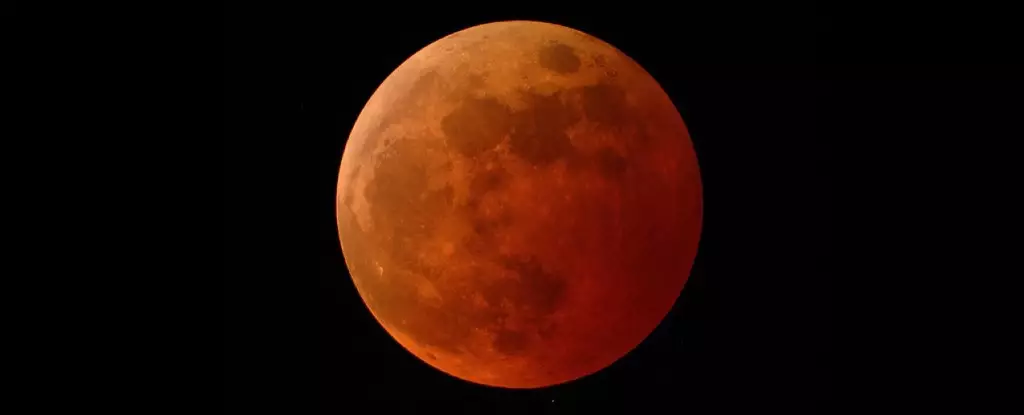On the night of an extraordinary total lunar eclipse, an event known colloquially as the “Blood Worm Moon” promises to captivate skywatchers from various corners of the Earth. This spectacular phenomenon occurs when the Earth aligns perfectly between the Sun and the Moon, casting a grand shadow that bathes our lunar companion in a surreal rosy glow. Daniel Brown, an esteemed astronomer from Nottingham Trent University, elucidates that this eye-catching transformation arises because sunlight enters through the Earth’s atmosphere and is “bent and scattered.” The same phenomenon can be observed during stunning sunrises and sunsets, lending a sense of continuity and beauty to our celestial cycles.
What’s noteworthy about the Blood Worm Moon is its red hue, often viewed as an omen or a message by different cultures throughout history. While some may find its name foreboding, it is essential to understand that the celestial event is a brilliant display of the universe’s mechanics—an awe-inspiring testament to the wonders of cosmic alignment.
Viewing Opportunities Across the Globe
The excitement surrounding this lunar event stretches across the Americas, the Pacific and Atlantic Oceans, and the western edges of Europe and Africa. Skywatchers in these regions are poised to witness a transformative spectacle. In North America, the eclipse begins around 1:09 AM Eastern Time, peaking with totality between 2:26 AM and 3:31 AM. Meanwhile, in parts of Europe, like France’s Brittany region, lucky observers will have a fleeting opportunity to relish the moment before the Moon sets.
In stark contrast, citizens of New Zealand will face a different dilemma: they will see only a partial view as the Moon rises, providing an imperfect but still beautiful glimpse of this cosmic dance. However, despite geographical and environmental challenges, the shared excitement and anticipation for this event unite diverse communities under the same night sky.
Cultural Significance and Historical Perspectives
The perception of lunar eclipses varies significantly among different cultures. While Brown expresses his distaste for the term “Blood Moon,” citing its negative connotations and roots in apocalyptic fears, other perspectives paint a much more harmonious picture. In certain African traditions, lunar eclipses symbolize a conflict resolution between the Sun and Moon, prompting onlookers to set aside their differences and engage in cooperative behaviors. This philosophical take serves as a beautiful reminder of human unity, offering an inspiring narrative amid contemporary challenges.
On the other hand, many Native American cultures have their own interpretations, often weaving rich tapestries of mythology around the full moons and eclipses—a testament to humanity’s enduring fascination with celestial events. Each story adds layers to our understanding of the universe while simultaneously enriching our cultural heritage.
Preparing for the Cosmic Event
As the Blood Worm Moon draws near, it is a moment to indulge in stargazing rituals, whether huddled with friends or alone under the cosmos. Enthusiasts recommend finding an unobstructed view, perhaps away from city lights, to fully appreciate the event’s beauty. Nevertheless, viewers in the UK might face challenges with less-than-ideal weather conditions, prompting a hopeful atmosphere as the community collectively desires a clear peek through the clouds.
Moreover, this year’s lunar eclipse coincides with what is known as a “Micromoon,” when the Moon is at its farthest point from the Earth, giving us a slightly smaller sight than usual. This unique aspect, juxtaposed against the larger backdrop of the lunar eclipse, further magnifies the event’s intrigue and allure.
The Next Celestial Wonders Await
While the Blood Worm Moon will mark a stunning highlight in this celestial calendar, skywatchers should keep their eyes peeled for the subsequent astronomical events, including an upcoming partial solar eclipse later in March. This reminds us that the universe is ever-changing and teeming with possibilities.
As we prepare for this lunar masterpiece, let’s take a moment to appreciate how celestial phenomena ripple through our understanding of nature and culture, inspiring awe and wonder throughout generations. Each event not only captivates our scientific curiosity but also invites us to reconnect with our shared heritage as inhabitants of this wondrous planet.


Leave a Reply